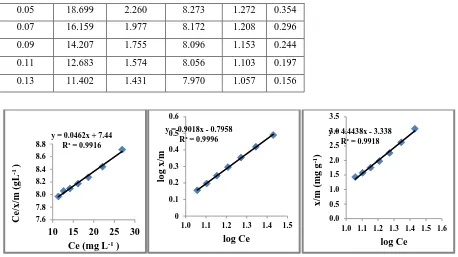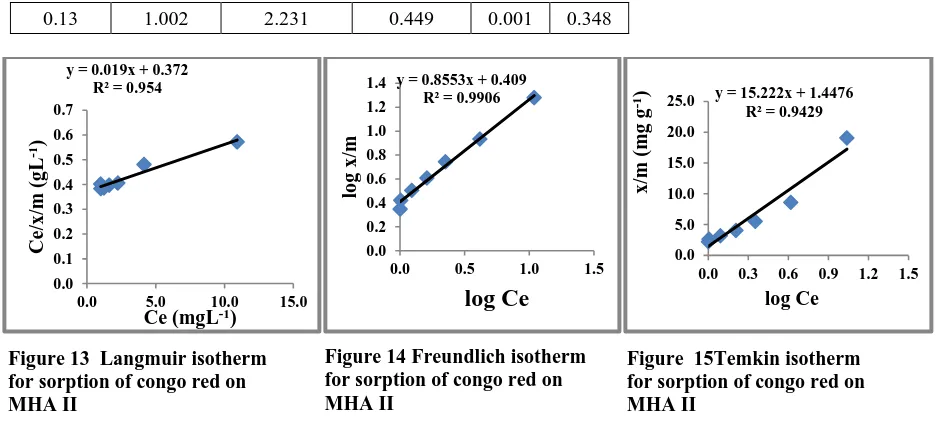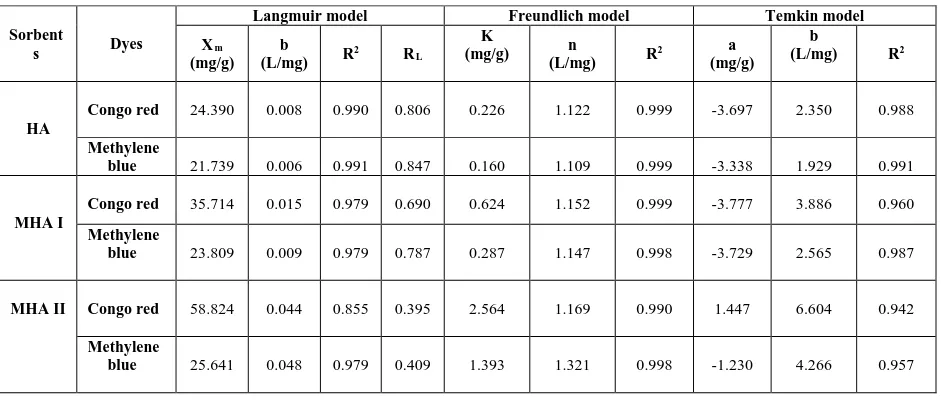http://dx.doi.org/10.29322/IJSRP.9.07.2019.p9145 www.ijsrp.org
A Study on the Adsorption Isotherms of Humic Acid and
Modified Humic Acids
Dr Than Than Aye*, Dr Lin Lin Tun** ** Department of Chemistry, Yenanchaung Degree College
drthanaye325@gmail.com
DOI: 10.29322/IJSRP.9.07.2019.p9145
http://dx.doi.org/10.29322/IJSRP.9.07.2019.p9145
Abstract- The present research aims the preparation of modified humic acids to be used as the effective sorbents for the removal of acid dye and basic dye. The sub-bituminous coal samples occurred at Tekyit mine (Tekyit village, Pin Laung Township, Shan State), were received from Department of mine, Ministry of Mining, Myanmar. Three types of sorbents such as extracted humic acid (HA), physically modified humic acid (MHA I) and chemically modified humic acid (MHA II) were prepared. Sorption studies of three sorbents (HA, MHA I, MHA II) were carried out spectrophotometrically. Two model dyes, methylene blue as basic dye and congo red as acid dye were used in sorption experiments. There are many kinds of sorption parameters such as concentration of dye solution, pH of medium, contact time and temperature. Based on the dosage method, the maximum removal percent of congo red was found to be 46% by HA, 70% by MHA I and 93% by MHA II at the specified conditions such as initial dye concentration (30 mg L−1), dosage (0.05 g / 10 mL), pH (5) and contact time (1 h). In the care of methylene blue as sorbate, the maximum removal percent
was detected as 38% by HA, 51% by MHA I and 83% by MHA II under the conditions which were the same as sorbate congo red. Sorption isotherm studies corresponded to Langmuir, Freundlich and Temkin isotherms and significant sorption parameters were evaluated. Based on the Langmuir parameters, monolayer and sorption was achieved to indicate the favorable adsorptions of congo red and methylene blue on MHA II. Based on the manipulating data of isotherms, the sorption capacities of sorbents for the removal of congo red and methyylene blue were observed as the order of MHA II > MHA I > HA.
Keywords : Modified humic acids, acid and basic dye, isotherm, Langmuir, Freundlich, Temkin
I. INTRODUCTION
Humic acid is one of the main component portions of the naturally occurring humic substances that occur in soil, compost, sludge, in various rank coal peat, lignite, sub bituminous, etc. and all aquatic sediments. Its colour can range from dark brown to black. It is a highly complex polymeric substance, comprising a mixture of aromatic groups and other different compounds including amino acids, amino sugar, peptides, aliphatic acids and other aliphatic compound. It is important in soil chemistry due to its buffering capacity. Humic acid and other derivatives can be used for removing toxic metals and their ions from waste water (Aiken et al., 1985). Extensive works in the nature of humic substances, their characterization and applications have been reported elsewhere (Stevenson, 1994).Humic substances are major constituents of soil chemical and physical quality and are precursor of some fossil fuels. They can also be found in peat, coal and ocean water. They function to give the soil structure, porosity, high adsorption capacity, high
exchange capacity and are involved in the chelation of mineral elements. Humic substances are usually separated into three fractions: humic acids, fulvic acids and humins. These fractions are defined strictly on their solubility in their acid or alkali solutions (Aiken, 1985).
II. MATERIAL AND METHODS
The collected coal sample was prepared humic acid(HA) by extraction method. This research work is concerned with the preparation and modification\of humic acid and modified humic acids. Physically modified humic acid (MHA I)was prepared by heating process of extracted humic acid and chemically modified humic acid (MHA II) was prepared by adding calcium chloride and by heating process of extracted humic acid. Two model dyes, methylene blue as basic dye and congo red as acid dye were used in sorption experiments.
The colour removal of congo red and methylene blue (initial concentration 30 mgL
-1) by
various dosage of humic acid (HA)and modified humic acids(MHA I and MHA II)in 10 mL dye solution for
removal of dye were also determined by varying the adsorbent dosage from 0.01 g to 0.13 g under the ame
conditions. Based on the sorbent dose effect,
sorption isotherm studies corresponded to Langmuir, Freundlich and Temkinisotherms and significant sorption parameters were evaluated.
http://dx.doi.org/10.29322/IJSRP.9.07.2019.p9145 www.ijsrp.org
The effect of dosage was studied the color removal of congo red and methylene blue from a constant initial concentration of 30 mgL-1
by the amount of sorbents HA, MHA I and MHA II in range from 0.01 g to 0.13 g in 10 mL congo red solution. For the sorbent of 0.05 g in 10 mL, it was found that after 60 min agitation time, the amount of dye being adsorbed were 45.78 % for HA, 70.04 % for MHA I and 92.51 % for MHA II. The percent removal of methylene blue increases with respect to increase in sorbent dosage. The percent removal were 37.67 % for HA, 50.61 % for MHA I and 82.91 % for MHA II with respect to 0.05 g in 10 mL of methylene blue solution after the equilibrium time. The higher percent removal capacity may be attributed to the greater quantity of sorbent dose being used. This is due to increased in sorbent dosage attributed to increase in surface area and availability of adsorption site. The dosage method involves the use of different masses of sorbent, but a fixed initial concentration of the sorbate at a certain temperature. Here, to reveal the significance of the removal of congo red and methylene blue, the well-known isotherms were applied such as Langmuir isotherm, Freundlich isotherm and Temkin isotherm.
Table (1 - 6) represent the data and Figures ( 1- 18 )
showed the Langmuir, Freundlich and Temkin isotherms pertaining to sorption equations.
The calculated results
of the Langmuir, Freundlich and Temkin isotherm constants are presented in Table 7.
Table 1 Data Treatment of Langmuir, Freundlich and Temkin Isotherms for Sorption of Congo Red by HA (Dosage Method)
pH = 5 Contact tim = 1 h Initial Concentration= 30 mgL-1
Temperature = 30ºC Stirring rate = 100 rpm
Table 2 Data Treatment of Langmuir, Freundlich and Temkin
Isotherms for Sorption of Methylene Blue by HA (Dosage)
Mass
(g/10mL) Ce
(mgL-1)
x/m
(mg g-1)
Ce/x/m
(gL-1) log Ce
log
x/m
0.01 26.911 3.089 8.712 1.430 0.490 0.03 22.134 2.622 8.442 1.345 0.419
y = 0.041x + 5.2614 R² = 0.9908
5.5 5.7 5.9 6.1 6.3 6.5
0 8 16 24 32 40
C
e/
x
/m
(
g
L
-1)
Ce (mgL-1)
y = 0.8919x - 0.6444 R² = 0.9993
0.0 0.1 0.2 0.3 0.4 0.5 0.6 0.7
0.8 1.0 1.2 1.4 1.6
log
x/
m
log Ce
y = 5.4112x - 3.6974 R² = 0.9885
0 1 2 3 4 5
0.8 1.0 1.2 1.4 1.6
x
/m
(mg
g
-1)
log Ce Mass
(g/10mL)
Ce (mgL-1)
x/m (mg g-1)
Ce/x/m
(gL-1) log Ce log x/m
0.01 25.918 4.082 6.349 1.414 0.611 0.03 20.063 3.312 6.057 1.302 0.520 0.05 16.266 2.747 5.922 1.211 0.439 0.07 13.576 2.346 5.786 1.133 0.370 0.09 11.677 2.036 5.736 1.067 0.309 0.11 10.253 1.795 5.711 1.011 0.254 0.13 9.082 1.609 5.644 0.958 0.207
Figure 1 Langmuir isotherm for sorption of Congo Red
on HA
pH = 5 Contact tim = 1 h Initial Concentration= 30 mgL -1Temperature = 30ºC
Stirring rate = 100 rpm
Figure 2 Freundlich isotherm for sorption of Congo Red
on HA
Figure 3 Temkin isotherm for sorption of Congo Red
on HA
Table 2 Data Treatment of Langmuir, Freundlich and TemIsotherms
[image:2.612.38.548.231.585.2]http://dx.doi.org/10.29322/IJSRP.9.07.2019.p9145 www.ijsrp.org
0.05 18.699 2.260 8.273 1.272 0.354 0.07 16.159 1.977 8.172 1.208 0.296 0.09 14.207 1.755 8.096 1.153 0.244 0.11 12.683 1.574 8.056 1.103 0.197 0.13 11.402 1.431 7.970 1.057 0.156
Mass
(g/10mL) Ce
(mgL-1)
x/m
(mg g-1)
Ce/x/m
(gL-1) log Ce
log
x/m
0.01 21.234 8.766 2.422 1.327 0.943 0.03 12.785 5.738 2.228 1.107 0.759 0.05 8.987 4.203 2.138 0.954 0.624 0.07 6.772 3.318 2.041 0.831 0.521 0.09 5.475 2.725 2.009 0.738 0.435 0.11 4.557 2.313 1.970 0.659 0.364 0.13 3.861 2.011 1.920 0.587 0.303
y = 0.0462x + 7.44 R² = 0.9916
7.6 7.8 8.0 8.2 8.4 8.6 8.8
10 15 20 25 30
C e/ x /m ( g L -1)
Ce (mg L-1)
y = 0.9018x - 0.7958 R² = 0.9996
0 0.1 0.2 0.3 0.4 0.5 0.6
1.0 1.1 1.2 1.3 1.4 1.5
log
x/
m
log Ce
y = 4.4438x - 3.338 R² = 0.9918
0.0 0.5 1.0 1.5 2.0 2.5 3.0 3.5
1.0 1.1 1.2 1.3 1.4 1.5 1.6
x /m (mg g -1) log Ce
y = 0.028x + 1.8491 R² = 0.9793
1.0 1.5 2.0 2.5 3.0
0 10 20 30
C e/ x /m ( g L -1)
Ce (mgL-1)
y = 0.8681x - 0.2051 R² = 0.9998
0.0 0.2 0.4 0.6 0.8 1.0
0.5 0.7 0.9 1.1 1.3 1.5
log
x/
m
log Ce
y = 8.9497x - 3.7773 R² = 0.9606
0 2 4 6 8 10
0.5 0.7 0.9 1.1 1.3 1.5
x/ m ( m g g -1) log Ce Table 3 Data Treatment of Langmuir, Freundlich and Temkin
Isotherms for Sorption of Congo Red by MHA I (Dosage Method) Figure 4 Langmuir isotherm
for sorption of methylene blue on HA
Figure 5 Freundlich isotherm for sorption of methylene blue
on HA
Figure 6 Temkin isotherm for sorption of methylene blue on HA
pH = 5 Contact tim = 1 h
InitialConcentration=30mgL-1Temperature = 30ºC
Stirring rate = 100 rpm
Figure8Freundlich isotherm for sorption of congo red on MHA I
Figure 9 Temkin isotherm for sorption of congo red on MHA I
[image:3.612.34.492.51.308.2] [image:3.612.39.502.401.724.2]http://dx.doi.org/10.29322/IJSRP.9.07.2019.p9145 www.ijsrp.org
Mass (g/10mL)
Ce (mgL-1)
x/m (mg g-1)
Ce/x/m
(gL-1) log Ce
log x/m
0.01 10.918 19.082 0.572 1.038 1.281 0.03 4.146 0.618 0.481 0.618 0.935 0.05 2.247 5.540 0.406 0.352 0.744 0.07 1.614 4.055 0.398 0.208 0.608 0.09 1.234 3.196 0.386 0.091 0.505 0.11 1.013 2.635 0.384 0.006 0.421
y = 0.0428x + 4.2388 R² = 0.9793
4 4.4 4.8 5.2 5.6 6
0 7 14 21 28 35
C
e/
x
/m
(
g
L
-1)
Ce (mgL-1)
y = 0.8727x - 0.5429 R² = 0.9984
0 0.1 0.2 0.3 0.4 0.5 0.6 0.7 0.8
0.8 1 1.2 1.4 1.6
log
x/
m
log Ce
y = 5.9086x - 3.7297 R² = 0.9873
0 1 2 3 4 5
0.8 1 1.2 1.4 1.6
x
/m
(mg
g
-1)
log Ce Mass
(g/10mL)
Ce
(mgL-1)
x/m
(mg g-1)
Ce/x/m
(gL-1) log Ce
log x/m
0.01 25.264 4.736 5.334 1.403 0.675 0.03 18.821 3.726 5.051 1.275 0.571 0.05 14.817 3.037 4.879 1.171 0.482 0.07 12.012 2.57 4.674 1.080 0.410 0.09 10.244 2.195 4.667 1.010 0.341 0.11 8.902 1.918 4.641 0.949 0.283 0.13 7.866 1.703 4.620 0.896 0.231
Table 4 Data Treatment of Langmuir, Freundlich and TemIsotherms
for Sorption of Methylene Blue by MHA I (Dosage Method
Table 3.13(a) Data Treatment of Langmuir, Freundlich and Temkin
Isotherms for Sorption of Congo Red on MHA II (Dosage
M th d)
pH =5 Contact time = 1 h
Initial Concentration= 30 mgL-1
Temperature = 30ºC
Stirring rate = 100 rpm
[image:4.612.39.559.155.527.2]Figure10 Langmuir isotherm for sorption of methylene blue on MHA I
Figure 11 Freundlich isotherm for sorption of methylene blue on MHA I
Figure 12Temkin isotherm for sorption of methylene blue on MHA I
Table 5 Data Treatment of Langmuir, Freundlich and Temkin
Isotherms for Sorption of Congo Red by MHA II (Dosage Method)
pH =5 Contact time = 1 h
Initial Concentration= 30 mgL-1
Temperature = 30ºC
http://dx.doi.org/10.29322/IJSRP.9.07.2019.p9145 www.ijsrp.org
0.13 1.002 2.231 0.449 0.001 0.348
Table 6 Data Treatment of Langmuir, Freundlich and Temkin Isotherms for Sorption of Methylene Blue by MHA II( Dosage Method)
pH =5 Contact time = 1 h
Initial Concentration= 30 mgL-1
Temperature = 30ºC
Stirring rate = 100 rpm
y = 0.019x + 0.372 R² = 0.954
0.0 0.1 0.2 0.3 0.4 0.5 0.6 0.7
0.0 5.0 10.0 15.0
C e/ x /m ( g L -1)
Ce (mgL-1)
y = 0.8553x + 0.409 R² = 0.9906
0.0 0.2 0.4 0.6 0.8 1.0 1.2 1.4
0.0 0.5 1.0 1.5
log
x/
m
log Ce
y = 15.222x + 1.4476 R² = 0.9429
0.0 5.0 10.0 15.0 20.0 25.0
0.0 0.3 0.6 0.9 1.2 1.5
x /m (mg g -1) log Ce
y = 15.222x + 1.4476 R² = 0.9429
0.0 5.0 10.0 15.0 20.0 25.0
0.0 0.3 0.6 0.9 1.2 1.5
x /m (mg g -1) log Ce
y = 0.019x + 0.3726 R² = 0.9545
0.0 0.1 0.2 0.3 0.4 0.5 0.6 0.7
0.0 5.0 10.0 15.0
C e/ x /m ( g L -1)
Ce (mgL-1)
y = 0.8553x + 0.409 R² = 0.9906
0.0 0.2 0.4 0.6 0.8 1.0 1.2 1.4
0.0 0.5 1.0 1.5
log x/ m log Ce Mass (g/10mL) Ce (mgL-1)
x/m (mg g-1)
Ce/x/m
(gL-1) logCe
log x/m
0.01 17.907 12.093 1.481 1.253 1.083 0.03 8.638 7.121 1.213 0.936 0.853 0.05 5.061 4.988 1.015 0.704 0.698 0.07 3.617 3.769 0.960 0.558 0.576 0.09 2.764 3.026 0.913 0.442 0.481 0.11 2.235 2.524 0.885 0.349 0.402 0.13 1.849 2.165 0.854 0.267 0.335
[image:5.612.36.511.53.264.2]Figure 13 Langmuir isotherm for sorption of congo red on MHA II
Figure 14 Freundlich isotherm for sorption of congo red on MHA II
[image:5.612.45.521.65.762.2]Figure 15Temkin isotherm for sorption of congo red on MHA II
Figure 16 Langmuir isotherm for sorption of methylene blue on MHA II
Figure 17 Freundlich isotherm for sorption of methylene blue on MHA II
[image:5.612.40.511.348.690.2]http://dx.doi.org/10.29322/IJSRP.9.07.2019.p9145 www.ijsrp.org
Table 7 Langmuir, Freundlich and Temkin Parameters for the Adsorption of Dyes
Sorbent
s Dyes
Langmuir model Freundlich model Temkin model
Xm
(mg/g) b (L/mg) R
2 R
L
K
(mg/g) n
(L/mg) R
2 a
(mg/g) b
(L/mg) R2
HA
Congo red 24.390 0.008 0.990 0.806 0.226 1.122 0.999 -3.697 2.350 0.988 Methylene
blue 21.739 0.006 0.991 0.847 0.160 1.109 0.999 -3.338 1.929 0.991
MHA I
Congo red 35.714 0.015 0.979 0.690 0.624 1.152 0.999 -3.777 3.886 0.960 Methylene
blue 23.809 0.009 0.979 0.787 0.287 1.147 0.998 -3.729 2.565 0.987
MHA II Congo red 58.824 0.044 0.855 0.395 2.564 1.169 0.990 1.447 6.604 0.942 Methylene
blue 25.641 0.048 0.979 0.409 1.393 1.321 0.998 -1.230 4.266 0.957
HA = Humic acid
MHA I = Modified humic acid (physical modification ) MHA II = Modified humic acid (chemical modification )
4. CONCLUSION
Chemically modified humic acid (MHA II) as effective and low cost adsorbent for the removal of acid dye and basic dye were investigated. Physically modified humic acid (MHA I) was prepared by heating process of extracted humic acid and chemically modified humic acid (MHA II) was prepared by treating with calcium chloride. There are many kinds of sorption parameters such as concentration of dye solution, pH of medium, contact time, sorbent dose and temperature. Among these parameters, the effect of sorbent dose was studied in this paper. The maximum removal percent of congo red were found to be 46% of HA, 70% of MHA I and 93% of MHA II at 30 mgL-1 of initial dye concentration, 0.05 g/10 mL of dosage, pH 5 and 1 h of contact time. The maximum
removal percent of methylene blue byHA, MHA I and MHA II were found to be 38%, 51% and 83% respectively under the same conditions. Sorption isotherm studies using relevant isotherm equation corresponded Langmuir and Freundlich as well as Temkin were applied and significant sorption parameters were evaluated. According to these isotherms, the sorption capacities of congo red and methylene blue on sorbents in the order of MHA II > MHA I > HA were observed. MHA II was the most effective and efficient sorbent for acid dye, basic dye. HA, MHA I and MHA II could be applied in purifying the environmentally color polluted waste water bodies.
APPENDIX
Langmuir isotherm equation 𝑪𝑪𝑪𝑪
𝒙𝒙/𝒎𝒎
=
𝟏𝟏 𝑿𝑿𝒎𝒎𝒃𝒃+
𝑪𝑪𝑪𝑪 𝑿𝑿𝒎𝒎
Freundlich isotherm equation
log
𝒙𝒙𝒎𝒎
=
𝟏𝟏𝒏𝒏
log
Ce +log K
Temkin isotherm equation 𝒙𝒙
𝒎𝒎
=a + 2.303b
log
Ce𝒙𝒙𝒎𝒎 =the amount of sorbate (x) adsorbed per unit mass of sorbent Ce = quilibrium concentration of the sorbate in solution
Xm = the maximum monolayer amount of sorbate per unit mass of sorbent
b = Langmuir constant related to the affinity between the sorbent and sorbate n,K = constant
ACKNOWLEDGMENT
[image:6.612.39.513.72.278.2]http://dx.doi.org/10.29322/IJSRP.9.07.2019.p9145 www.ijsrp.org
REFERENCES
[1]F.T. Stevenson, “Humus Chemistry, Genesis, Composition, Reactions”, 2nd Edn, New York: John Wiley, Inc.,1994, pp 12-36
[2]G. G. Choudhary , “Humic Substances, Sorptive Interaction with Environmental Chemicals”, New York: Toxicological & Environmental Chemistry, 1983, pp 15-80
[3]G.R. Aiken et al., “Humic Substances in Soil, Sediment and Water”, New York: John Wiley & Sons., 1985, pp 70-98 [4]R.L., Wershaw, “Humic Substances in Soil”, New York: John Wiley & Sons.Inc., 1997, pp 10-35
[5]H. Seki, and A. Suzuki, “Adsorption of Heavy Metal Ions onto Insolubilized Humic Acid”, J. Colloid Interface Sci., 1995, pp 1-17, 470-494
[6]Y.N. Slokar, and A.L. Marechal, “Methods of Decolouration of Textile Waste Water, Dyes and Pigments, 1998, 37,335-356 AUTHORS
First Author – Dr Than Than Aye, Department of Chemistry, Yenanchaung Degree College, drthanaye325@gmail.com




